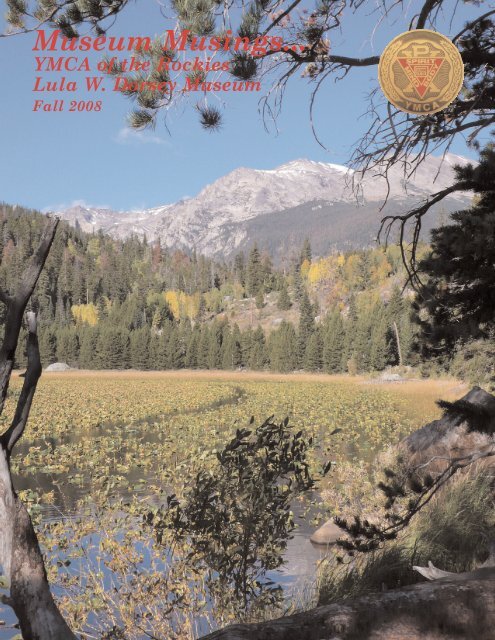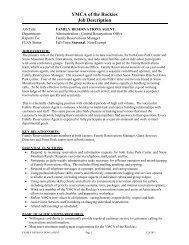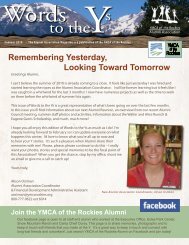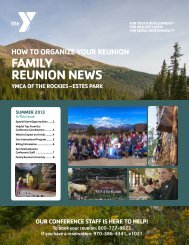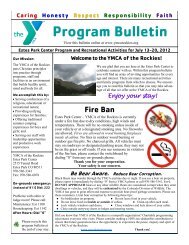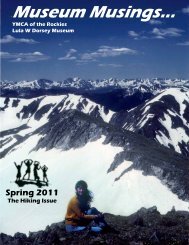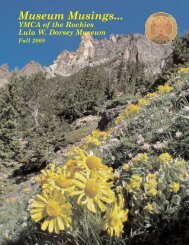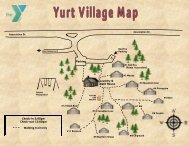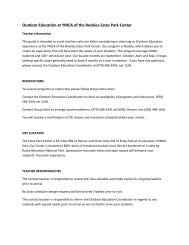Fall 2008 RGB.qxd - YMCA of the Rockies
Fall 2008 RGB.qxd - YMCA of the Rockies
Fall 2008 RGB.qxd - YMCA of the Rockies
- No tags were found...
You also want an ePaper? Increase the reach of your titles
YUMPU automatically turns print PDFs into web optimized ePapers that Google loves.
Museum Musings...<strong>YMCA</strong> <strong>of</strong> <strong>the</strong> <strong>Rockies</strong>Lula W. Dorsey Museum<strong>Fall</strong> <strong>2008</strong>
2 - <strong>Fall</strong> <strong>2008</strong>View From <strong>the</strong> Museum PorchThe fall colors havecome and gone. And aglorious fall it was.Unlike some years when<strong>the</strong> lack <strong>of</strong> moistureleaves us crackling dry,this year's ample rainsmade for a spectaculardisplay <strong>of</strong> fall colors. Aswe've said in <strong>the</strong> past,fall is <strong>the</strong> carrot on <strong>the</strong>end <strong>of</strong> <strong>the</strong> stick after a busy summer in Estes Park.Each summer is different, but this one was veryspecial since it was <strong>the</strong> thirtieth summer <strong>of</strong> operationfor <strong>the</strong> Dorsey Museum. With that milestone cameour thirty-year <strong>YMCA</strong> service pins. It was a bit <strong>of</strong> areality check to think that we've both worked at <strong>the</strong>Y almost half <strong>of</strong> our lives!One <strong>of</strong> <strong>the</strong> highlights <strong>of</strong> this summer was <strong>the</strong> celebration<strong>of</strong> Camp Chief Ouray's centennial on LaborDay weekend. Staff and camper alumni ga<strong>the</strong>red toreminisce and have fun. We had <strong>the</strong> opportunity tospend <strong>the</strong> entire weekend having fun with <strong>the</strong>m. Besure to check out our feature story later in thisnewsletter.We are really excited about <strong>the</strong> opportunity tosave Purple Finch cabin from <strong>the</strong> landfill to serve asarchive storage and an exhibit preparation workspace. Be sure to read about how you can help withthis special project.This past summer was spent doing what we lovebest about our jobs, visiting with old friends andOur Mission:To support <strong>the</strong> Mission <strong>of</strong> <strong>the</strong> <strong>YMCA</strong> <strong>of</strong> <strong>the</strong> <strong>Rockies</strong>through preservation and documentation <strong>of</strong> our corporatehistory by:Collecting, preserving, and interpretingcultural artifacts related to <strong>the</strong> <strong>YMCA</strong>'shistory in a museum venue,Offering interpretive programs to guestsand members,Identifying and participating in <strong>the</strong>preservation <strong>of</strong> historically significantbuildings and sites,Actively researching and publishingmaterials related to our history.Museum Musings <strong>Fall</strong> <strong>2008</strong> (Vol. 25, No. 2)Lula W. Dorsey Museumwww.ymcarockiesmuseum.org<strong>YMCA</strong> <strong>of</strong> <strong>the</strong> <strong>Rockies</strong>Post Office Box 20550Estes Park, CO 80511970-586-3341 ext. 1136 or 1240jmelton@ymcarockies.orgmaking new ones. After last summer's whirlwind <strong>of</strong>centennial events, we decided to get back to a morenormal routine, whatever that might be. We accompanied<strong>YMCA</strong> guided hikes to interpret archaeology,history and natural history. At <strong>the</strong> request <strong>of</strong> somecoworkers, we even forced our wobbly knees to climb<strong>the</strong> side <strong>of</strong> Mt. Chapin to visit Miner Bill's Mine. Itwas just as steep and beautiful as we remembered.We had an interesting critter time around <strong>the</strong>Dorsey Museum this summer. In early June, Jackheard what could only be described as an alien-likesound emanating from <strong>the</strong> spruce tree in <strong>the</strong> frontyard. Closer examination revealed a Magpie nest.Each time a parent would return to <strong>the</strong> nest with ameal, <strong>the</strong> young magpies would raise a ruckus.Unfortunately, <strong>the</strong>y fledged on a Sunday morning,and we were not around to see <strong>the</strong> excitement.After several years <strong>of</strong> declining numbers, <strong>the</strong> hummingbirdpopulation at <strong>the</strong> museum was way up thisyear. Although <strong>the</strong> number <strong>of</strong> birds was nothing like<strong>the</strong> 1980s and 90s, it was nice to again see <strong>the</strong>m inholding patterns awaiting an opening at <strong>the</strong> feeders.The local moose population still seems to be growing.There have been sightings all summer on <strong>the</strong>east side <strong>of</strong> <strong>the</strong> National Park. Most recently, amoose was seen foraging in Sprauge Lake.The bears have been <strong>the</strong>ir usual opportunisticselves. Bear pro<strong>of</strong> trash cans and frequent trash pickupsby Buildings and Grounds have helped <strong>the</strong> bearsstay out <strong>of</strong> trouble. One afternoon, Day Camp put<strong>the</strong>ir picnic leftovers in <strong>the</strong> museum trash can. Mr.Bear had a fine feast that night. Can't say much forhis table manners. What a mess! From <strong>the</strong>n on wefurnished trash bags for Day Camp to haul <strong>of</strong>f <strong>the</strong>irleftovers.The morning <strong>of</strong> July 21 was a "Bambi" moment at<strong>the</strong> museum. When we arrived for work <strong>the</strong>re was avery small rabbit scurrying around <strong>the</strong> parking lot.Then a black abert squirrel ran up <strong>the</strong> flagpole andback down. A momentlater, a doe and two tinyfawns appeared in <strong>the</strong>yard. While Jack ranupstairs to grab <strong>the</strong> camera,<strong>the</strong> rabbit and fawnsstarted bouncing and scamperingaround <strong>the</strong> yardtoge<strong>the</strong>r. Lulie called it a“Walt Disney” moment butwas reminded later thatDisney is fiction and whatwe saw was real. One <strong>of</strong><strong>the</strong> fawns later disappeared,but <strong>the</strong> remaining one and its mo<strong>the</strong>r kept<strong>the</strong> bushes trimmed <strong>the</strong> rest <strong>of</strong> <strong>the</strong> summer.We know that many <strong>of</strong> you keep up on <strong>the</strong> localwea<strong>the</strong>r through <strong>the</strong> museum website. The virtual
3 - <strong>Fall</strong> <strong>2008</strong>wea<strong>the</strong>r station page has had 30,000 viewings sincegoing live in January. The Ypsilon webcam has hadover 100,000 hits by "homesick" Y folks. You can seeboth <strong>the</strong> wea<strong>the</strong>r and <strong>the</strong> webcam at:www.ymcarockiesmuseum.org/wea<strong>the</strong>r.htm.Now for our personal wea<strong>the</strong>r observations… LateMay and early June were unusually cool and wet. Wereally didn't experience summer temperatures anddryer wea<strong>the</strong>r until mid-June. The cooler wea<strong>the</strong>rdelayed <strong>the</strong> early flowers making <strong>the</strong>m overlap withlater blooming summer flowers. The alpine forgetme-notswere especially pr<strong>of</strong>use this year.Just about <strong>the</strong> time we started to complain <strong>of</strong> dryness,<strong>the</strong> summer monsoons arrived. Thankfully, wedidn't get <strong>the</strong> violent summer thunderstorms. It waskind <strong>of</strong> like <strong>the</strong> old days when it would cloud up andrain in <strong>the</strong> afternoon and clear by sunset.Through <strong>the</strong> years you've heard us whine about<strong>the</strong> August "brownout" when everything gets cracklingdry. Not this year. Just as <strong>the</strong> grasses began tohead out, we had a major monsoon event fromAugust 15-17. During that period, we had almost1.75" <strong>of</strong> rain. The mountains got several inches <strong>of</strong>snow as temperatures hovered in <strong>the</strong> upper 30s andlow 40s. When <strong>the</strong> clouds cleared, seasonal stafferJerry Suchman captured <strong>the</strong> scene below.Less than thirty days later, ano<strong>the</strong>r cold front hit<strong>the</strong> Front Range. Moisture from a Pacific hurricanegot caught up in a cold front. Estes again receivedover 1.5" <strong>of</strong> rain. This time <strong>the</strong> mountains really gothammered. They stayed completely white for severaldays. Everybody kept griping about it being too earlyfor such wea<strong>the</strong>r. Then Mo<strong>the</strong>r Nature blessed uswith day after day <strong>of</strong> beautiful Indian Summerwea<strong>the</strong>r to compliment <strong>the</strong> golden aspen leaves.After a two and a half month cessation, constructionrelated to <strong>the</strong> redevelopment <strong>of</strong> <strong>the</strong> core campusat Estes Park resumed in mid-August. Work beganby removing <strong>the</strong> last three buildings scheduled fordemolition. First to go was <strong>the</strong> commercial/guestlaundry. Remember those dust bunnies that growunder your washer at home? Well, you can imagine<strong>the</strong> size <strong>of</strong> <strong>the</strong> lint balls that appeared when <strong>the</strong>machines were moved! The giant jaws <strong>of</strong> destructionmade short work <strong>of</strong> <strong>the</strong> laundry.Then painfully we had to say good-bye to Pioneerand Fern-Odessa. Jack took a last walk through onAugust 15. He was amazed at <strong>the</strong> deteriorated condition<strong>of</strong> <strong>the</strong> buildings. Our summer senior stafferswere especially saddened to see Pioneer go, but itwas time.By early September, <strong>the</strong> construction <strong>of</strong> <strong>the</strong> newlodges and conference center was in full swing. Thecrunching noise <strong>of</strong> buildings coming down wasreplaced by growling diesel engines as tons <strong>of</strong> dirtwere moved about. In between growls was <strong>the</strong> incessantbeep, beep, beep <strong>of</strong> reverse warning beepers. Afriend <strong>of</strong> ours brought his young grandson over to seeall <strong>the</strong> big equipment. The wide-eyed toddler smiledbroadly as he mimicked <strong>the</strong> beep, beep, beep…If you want to keep up with <strong>the</strong> core area construction,go <strong>the</strong> construction webcam athttp://oxblue.com/pro/open/neenan/ymcarockies. It'sgot some really cool features.Ground was broken on two very significant projectsin September. Staff and guests ga<strong>the</strong>red on <strong>the</strong>4th to celebrate construction <strong>of</strong> <strong>the</strong> Legett ChristianCenter. This religious activity center will greatlyenhance <strong>the</strong> chaplaincy program. The second groundbreaking was for <strong>the</strong> Craft and Design Center. Bothbuildings will be ready in time for next summer.When people ask, "What do you do in <strong>the</strong> winter?"our response is something like, "That is when we getmost <strong>of</strong> our work done." As we began researching <strong>the</strong>Y's centennial book in <strong>the</strong> fall <strong>of</strong> 2004, we grappledwith <strong>the</strong> sheer volume <strong>of</strong> <strong>the</strong> Dorsey Museum’sarchives. It was like <strong>the</strong> nine-hundred pound gorillain <strong>the</strong> room. You try to ignore it by pretending it'snot <strong>the</strong>re.Even though our research was aided immensely bya hundred page index <strong>of</strong> <strong>the</strong> archives compiled bymuseum volunteer Marcia Taylor, we realized thatLongs Peak and <strong>the</strong> Front Range, August 16. Photograph by Jerry Suchman.
4 - <strong>Fall</strong> <strong>2008</strong>we carry around too much information in our collectiveheads. It's time to dump our memories before <strong>the</strong>"hard disks" crash!Museum volunteer Jeanne Gorze is cleaning up<strong>the</strong> index and formatting it for uniformity. Then wewill <strong>the</strong>n start annotating <strong>the</strong> index with additionalcomments. After that is done, <strong>the</strong> index will be madeavailable on <strong>the</strong> museum's website for researchers. Itwill take a couple <strong>of</strong> winters to get <strong>the</strong> index completelycross referenced.Time to cease with our personal ramblings and geton with <strong>the</strong> rest <strong>of</strong> <strong>the</strong> newsletter. Thanks to all <strong>of</strong>you who have supported <strong>the</strong> museum over <strong>the</strong> years.Keep warm and safe over <strong>the</strong> winter. Be sure to dropby and say hello if you are in <strong>the</strong> area.A quick check <strong>of</strong> <strong>the</strong>Internet confirmed thatLockwood did indeedbuild carriage lanterns.During his sparetime, Jesse spent severalweeks meticulously brazing<strong>the</strong> lantern backtoge<strong>the</strong>r. While stripping <strong>of</strong>f more layers <strong>of</strong> blackpaint, Jesse discovered that <strong>the</strong> original finish wassilver plate over brass. The silver plate was past saving,but it revealed that this had indeed been animpressive carriage lantern in its day.A Finishing TouchForMountainside LodgeFor years, we had admired <strong>the</strong> porch light thathung high above <strong>the</strong> door at John Timothy Stone'sMountainside Lodge. We could tell from <strong>the</strong> stylethat it was a carriage light. As Paul Harvey wouldsay, "Now for <strong>the</strong> rest <strong>of</strong> <strong>the</strong> story…"When <strong>the</strong> renovation <strong>of</strong> <strong>the</strong> Lodge began, <strong>the</strong> carriagelight was removed for safe keeping and repair.It was badly deteriorated and certainly didn't meetelectrical code. The plan was to have it powder coatedand reworked in time for last summer's reopening <strong>of</strong>Mountainside Lodge.Unfortunately, powder coating requires a veryhigh temperature. When <strong>the</strong> lantern was heated, <strong>the</strong>low temperature solder holding it toge<strong>the</strong>r instantlymelted. The light became a pile <strong>of</strong> jumbled pieces. Itwent into a box to await reassembly.Last winter, <strong>the</strong> job <strong>of</strong> reassembling it wasassigned to Jesse Ryan in Buildings and GroundsVehicle Maintenance. Jesse had <strong>the</strong> brazing skillsnecessary to put <strong>the</strong> lantern back toge<strong>the</strong>r. Problemwas that he didn't know what part went where.Imagine whose telephone rang?We started digging through pre-renovation photographsand came up with a ra<strong>the</strong>r fuzzy photograph.Jesse, Frank Palazolo, Eldon Kifer and Jack spent<strong>the</strong> better part <strong>of</strong> an hour looking at <strong>the</strong> photograph,staring at <strong>the</strong> pile <strong>of</strong> parts and rubbing collectivebrain cells toge<strong>the</strong>r. Finally, a unanimous decisionwas made as to <strong>the</strong> order <strong>of</strong> reassembly.A couple <strong>of</strong> days later, Jesse called Jack to saythat while removing paint he discovered a maker'sstamp. It read, "C.N. Lockwood & Co. Newark N.J."Jesse shows <strong>of</strong>f <strong>the</strong> reassembledLockwood carriage lantern.Home again!After <strong>the</strong> lantern was reassembled, Jack sent aphotograph to <strong>the</strong> Carriage Museum <strong>of</strong> America.Katharine Magruder identified it from its size andstyle as having been manufactured between 1865 and1875 for use on a funeral hearse!The question <strong>of</strong> course is how and when did thatlantern find its way to Mountainside Lodge? We haveno clue whatsoever.Revising History Before It HappenedIn <strong>the</strong> last edition, we told you <strong>the</strong> story <strong>of</strong> <strong>the</strong> oldlivery and how it became <strong>the</strong> teen barn and later <strong>the</strong>staff recreation building. No sooner had weannounced its impending conversion to a guest laundrythan our telephone rang. It was Y BoardMember, Steve Goldmann. He wanted to let us knowthat <strong>the</strong>re had been a slight change in plans.
5 - <strong>Fall</strong> <strong>2008</strong>It seems that upon closer inspection, structuralengineers determined that several tons <strong>of</strong> washersand dryers thumping around in what was once <strong>the</strong>hayl<strong>of</strong>t would be more than <strong>the</strong> old building couldtake. So scratch that plan. Sounded like ano<strong>the</strong>rbuilding headed for <strong>the</strong> landfill.That was a lot <strong>of</strong> square footage to just throwaway. Since it is adjacent to <strong>the</strong> new Buildings andGrounds shop, it was logical to turn it into storage.So, you can put a big red X through <strong>the</strong> story in<strong>the</strong> spring edition. Now let's see if <strong>the</strong> powers-that-bechange <strong>the</strong>ir minds after this story goes to press.We Need Your Help!In 1977, Walter Ruesch and Lula Dorsey had <strong>the</strong>foresight to preserve a portion <strong>of</strong> <strong>the</strong> old Wind RiverLodge. During <strong>the</strong> ensuing decades, <strong>the</strong> DorseyMuseum has been transformed from a summer-onlyhistorical museum into an important year-round programmingresource.Perhaps just as importantly, it is now <strong>the</strong> repositoryfor over one hundred years <strong>of</strong> corporate archivesdocumenting <strong>the</strong> delivery <strong>of</strong> <strong>the</strong> Y's mission to itsmembers. As Kent Meyer President/CEO wrote in hispreface to <strong>YMCA</strong> <strong>of</strong> <strong>the</strong> <strong>Rockies</strong>: Reflections,Traditions and Vision: We need to remember all <strong>the</strong>episodes in our history, <strong>the</strong> good and <strong>the</strong> bad and discern<strong>the</strong> lessons that will help us in our second century<strong>of</strong> service. Spanish born American poet andphilosopher George Santayana said, "Those who forget<strong>the</strong> past are condemned to repeat it."Through <strong>the</strong> years, you have faithfully supportednot only <strong>the</strong> day-to-day operations <strong>of</strong> <strong>the</strong> DorseyMuseum but some pretty significant projects. Now weneed your support for ano<strong>the</strong>r project.The upcoming construction <strong>of</strong> <strong>the</strong> Legett ChristianCenter at <strong>the</strong> Estes Park Center presented <strong>the</strong>Dorsey Museum with a unique opportunity and challenge.Purple Finch cabin was in <strong>the</strong> footprint <strong>of</strong> <strong>the</strong>new building. Last spring, we decided to save PurpleFinch cabin. It will be revitalized as archival storageand exhibit preparation space.Purple Finch 1919.Purple Finch was one <strong>of</strong> <strong>the</strong> original Wind RiverLodge tourist cabins built by <strong>the</strong> Estes Park Landand Investment Company in 1905. In 1910, <strong>the</strong> cabinwas moved from its original location south <strong>of</strong> <strong>the</strong>present livery to a spot just east <strong>of</strong> Hyde Chapel.Since <strong>the</strong> present Administration Building wasoriginally <strong>the</strong> Dining and Social Hall, Purple Finchwas in actuality <strong>the</strong> Y’s first “administration building.”In 1912, <strong>of</strong>fices were added to <strong>the</strong> Dining andSocial Hall and a new dining hall was constructed.Purple Finch <strong>the</strong>n became <strong>the</strong> executive director'ssummer residence. Through <strong>the</strong> ensuing decades,Purple Finch was used as guest accommodations,staff housing and lastly as meeting space.Adequate archival storage is an important part <strong>of</strong>preserving this Association's heritage. The current142 square feet <strong>of</strong> archival storage space at <strong>the</strong>Dorsey Museum is packed wall to wall and floor toceiling. Our storage issues were compounded after<strong>the</strong> volume <strong>of</strong> archival material almost doubled whilepreparing for <strong>the</strong> <strong>YMCA</strong> <strong>of</strong> <strong>the</strong> <strong>Rockies</strong> and CampChief Ouray centennials.Purple Finch's 442 square feet will more thanquadruple our storage space. It will also providemuch needed exhibit preparation and archival processingwork space.Purple Finch circa 1905 in its original location.Purple Finch on <strong>the</strong> way to its new home.
6 - <strong>Fall</strong> <strong>2008</strong>Now, our challenge is to pay for this opportunity.Due to <strong>the</strong> construction schedule for <strong>the</strong> religiousactivity center, we took <strong>the</strong> bold step <strong>of</strong> movingPurple Finch before funding was in place. The alternativefor Purple Finch was <strong>the</strong> bulldozer. Sometimesyou just have to go forward on faith.On August 27, Purple Finch was loaded on <strong>the</strong>moving truck and brought to <strong>the</strong> museum. The excavationand foundation work followed soon after. Thebuilding will be in its new home on <strong>the</strong> north side <strong>of</strong><strong>the</strong> museum in October.The total budget for moving, foundation and utilitiesis $45,000. We need all <strong>of</strong> you reading thisnewsletter to take a moment and make a donationspecifically for Purple Finch. It is vitally importantthat we protect <strong>the</strong> <strong>YMCA</strong> corporate archives andpreserve this historic cabin for future generations.To make a contribution, see <strong>the</strong> form on <strong>the</strong> backpage <strong>of</strong> this newsletter.What Makes Old GlassTurn Purple?When we were in college, we poked around trashdumps in East Texas looking for old bottles.Especially prized were bottles that had turned purplefrom exposure to <strong>the</strong> sun.Now, fast forward to 1979. That summer we werepoking around <strong>the</strong> <strong>YMCA</strong>'s trash dumps. Livery masterBill Robinson told us about a dump above <strong>the</strong> stables.Sure enough, <strong>the</strong> dump was loaded with tons <strong>of</strong>cans, broken dishes and glassware.Those <strong>of</strong> you who are students <strong>of</strong> Y history knowthat this is where <strong>the</strong> refuse from <strong>the</strong> December 1913collapse <strong>of</strong> <strong>the</strong> Dining Hall was dumped. When <strong>the</strong>ro<strong>of</strong> came crashing down under <strong>the</strong> weight <strong>of</strong> sevenfeet <strong>of</strong> snow, <strong>the</strong>re wasn't much left <strong>of</strong> <strong>the</strong> Y's tableware.This past summer, we were leading a group <strong>of</strong>guests on a history walk and stopped by <strong>the</strong> olddump to poke around. The ground was littered withfragments <strong>of</strong> glassware turned purple by <strong>the</strong> sun.Jack kicked one piece with <strong>the</strong> toe <strong>of</strong> his boot andturned it up. What was unusual about this particularpiece was that <strong>the</strong> part buried in <strong>the</strong> ground was stillclear.One guest asked, "What in old glass makes it turnpurple?" Jack told <strong>the</strong>m manganese was <strong>the</strong> elementthat turned old glass purple after long-term exposureto ultraviolet light.Some Internet research revealed that lead hadbeen used for centuries as a clarifying agent in glass.In <strong>the</strong> 1860s, <strong>the</strong> manganese was substituted for leadto make <strong>the</strong> glass brighter and to act as a stabilizer.About 1915, some but not all glass companies begansubstituting selenium for manganese. So, glassturned purple by <strong>the</strong> sun dates prior to or just afterWWI.Camp Chief Ouray Celebrates100 Years <strong>of</strong> Camp MagicSince 1885, <strong>YMCA</strong> resident camping has beenbuilding character in America's youth. Y youth campingwas still in its developmental phase when <strong>the</strong>Denver <strong>YMCA</strong> established Camp Chief Ouray in1908 in Granby, Colorado.This past Labor Day weekend, over 150 staff andcamper alumni and <strong>the</strong>ir families from <strong>the</strong> 1940s to<strong>the</strong> present ga<strong>the</strong>red to celebrate 100 years <strong>of</strong> campmagic. The three day event featured fun, food, campfiresand a host <strong>of</strong> camp activities.Having never attended a <strong>YMCA</strong> resident youthcamp as children, we've spent <strong>the</strong> last three yearsbecoming better acquainted with Camp Chief Ouray.We've learned that going to camp is a unique experiencethat is difficult to convey to <strong>the</strong> uninitiated.When Camp Chief Ouray was acquired from <strong>the</strong>Denver <strong>YMCA</strong> in 1980 and moved to Snow MountainRanch, <strong>the</strong> event created an emotional as well asphysical gap in <strong>the</strong> history <strong>of</strong> CCO. One <strong>of</strong> <strong>the</strong> goals<strong>of</strong> <strong>the</strong> centennial celebration was to bridge that gap.Friday's check-infelt more like a familyreunion than a centennialcelebration. Therewere hugs, kisses andpeals <strong>of</strong> laughter. Atraditional campfirewas <strong>the</strong> kick<strong>of</strong>f activityfor <strong>the</strong> evening.Reuniting with old friends.Saturday morningwe were treated to atour <strong>of</strong> <strong>the</strong> original camp. It was sort <strong>of</strong> like walkingthrough a time warp. When <strong>the</strong> old camp was sold,developers left some remnants <strong>of</strong> <strong>the</strong> campuntouched.The first stop was <strong>the</strong> old lodge, now a communitycenter, which was much like alumni remembered it.
7 - <strong>Fall</strong> <strong>2008</strong>Telling horse stories at old Camp Chief OurayWe were treated to a lot <strong>of</strong> reminiscing, much <strong>of</strong>which centered around horse stories. Former wranglershad everyone laughing.Next, we went on a tour <strong>of</strong> <strong>the</strong> property. Formercampers found familiar names written on <strong>the</strong> walls <strong>of</strong><strong>the</strong> rifle range. The chapel, complete with benches,was still <strong>the</strong>re as was <strong>the</strong> old horse barn.One <strong>of</strong> our responsibilities during <strong>the</strong> reunion wasto scan photographs and documents brought in byformer staff. Former camp nurse Juanita Muntz, anadmitted "string saver," brought us a cache <strong>of</strong> materialincluding rosters from <strong>the</strong> late 1960s and early70s. Those, along with many photographs, are nowposted on <strong>the</strong> alumni website.Saturday and Sunday were filled with traditionalcamp activities including tie-dying, hiking, canoeing,crafts and horseback riding. There were nightlycampfires with songs, crazy skits and <strong>of</strong> course,s'mores.One <strong>of</strong> <strong>the</strong> highlights <strong>of</strong> <strong>the</strong> weekend was a cookoutwith over 200 in attendance. Afterwards weshowed a historical DVD produced for <strong>the</strong> reunion.You can see a streaming version on line at:www.ymcarockiesalumni.org/CCOCentennialVideo.htmAt Sunday night's dinner, alumni sat toge<strong>the</strong>r bydecades. After <strong>the</strong> meal, alumni were asked to shareCamp Chief Ouray director Marty Ferguson leds a Rowdy Campfire cheer.<strong>the</strong>ir camp stories with<strong>the</strong> group. Some werefunny, o<strong>the</strong>rs were veryemotional. At first wewished we had brought atape recorder, but as wesat and listened, we realizedhow personal <strong>the</strong>sestories were. Eventhough <strong>the</strong> tales wereseparated by <strong>the</strong> span <strong>of</strong>decades, <strong>the</strong> <strong>the</strong>mesremained <strong>the</strong> same.Camp Chief Ouray hadbeen a life-changingexperience.As <strong>the</strong> weekend progressed,we noticed thatit made no difference if<strong>the</strong> alumni attended <strong>the</strong>original camp or <strong>the</strong> currentone, a feeling <strong>of</strong>spirit and camaraderieprevailed. All in attendanceagreed that CCOshould have ano<strong>the</strong>rreunion soon. Stay tunedfor details.S’moresWhile eating s'mores at <strong>the</strong>Camp Chief Ouray centennialreunion, we got to thinkingabout <strong>the</strong> origin <strong>of</strong> <strong>the</strong> campfiretreat.From what we could determine,<strong>the</strong> recipe for s'moresfirst appeared in 1927 inTramping and Trailing with<strong>the</strong> Girl Scouts.For those <strong>of</strong> you who areunfamiliar, s'mores are toastedmarshmallows and chocolatebetween two graham crackers.This campfire treat is consideredas American as baseballand apple pie.The name <strong>of</strong> this gooey delicacyis a contraction <strong>of</strong> "somemore." Here is a factoid for youtrivia nuts. August 10th isnational s'mores day!Camp Chief Ouray is one <strong>of</strong> 265 <strong>YMCA</strong> residentyouth camps in America serving 400,000 boys andgirls annually.The goals <strong>of</strong> building character and Christian personalityare as valid today as <strong>the</strong>y were in 1885. Byintentionally and purposefully imparting our CoreValues <strong>of</strong> Caring, Honesty, Respect, Responsibilityand Faith, Camp Chief Ouray will give future generations<strong>of</strong> youth a solid foundation upon which tobuild <strong>the</strong>ir lives.RememberingPioneer and Fern-Odessa LodgesIn our opening ramblings, we told you that wesaid farewell to Pioneer and Fern-Odessa Lodges thisfall.This was not <strong>the</strong> first time we said farewell to <strong>the</strong>old lodges. During <strong>the</strong> 1993 alumni reunion,Executive Director Gene Garris announced that at<strong>the</strong> end <strong>of</strong> <strong>the</strong> summer, Pioneer and Fern-Odessawould be coming down to make way for a new lodgeand conference center. The male seasonal staff <strong>the</strong>noccupying Pioneer, took that as a cue to have a"trashing party" as <strong>the</strong>y moved out at summer's end.Repairs were made in time for <strong>the</strong> summer <strong>of</strong> 1994.Pioneer and Fern-Odessa were built in 1921 assummer staff housing to replace disintegrating tents.
8 - <strong>Fall</strong> <strong>2008</strong>Each lodge consisted <strong>of</strong>four dorms and a socialhall with housing for asupervising matron.The matron was consideredessential since<strong>the</strong>re had been previousissues with rowdy unsupervisedcollege staff. Tisk, tisk, some things neverchange.At <strong>the</strong>ir time <strong>of</strong> construction, <strong>the</strong>se dorms weredeluxe housing since <strong>the</strong>y had steam heat and electricity.At some point <strong>the</strong> lodges were named Hallettand Ypsilon. In 1948, <strong>the</strong> Mummy Quadrangle wasconstructed to house staff. Hallett and Ypsilon were<strong>the</strong>n converted to conference housing.1919 staff housing.1990s, Pioneer became housing for <strong>the</strong> senior staffladies and Fern-Odessa became housing for <strong>the</strong> olderfemale college staff.As <strong>the</strong> senior ladies living in Pioneer left for <strong>the</strong>last time, <strong>the</strong>y took souvenirs such as doorknobs andsigns with <strong>the</strong>m. Sad to see <strong>the</strong> old lodges go, but <strong>the</strong>memories <strong>of</strong> <strong>the</strong> goods time had by <strong>the</strong> people wholived <strong>the</strong>re will endure.Make Your Reservation NowFor <strong>the</strong>June Alumni Relations!It is time to make your reservations for <strong>the</strong> 2009staff alumni reunions. The Alumni AssociationCouncil and Y staff are currently working on <strong>the</strong>schedule <strong>of</strong> activities. It's time to start digging outthose photographs and mementos and trying to putnames with all those faces.Ypsilon Lodge (Fern-Odessa), 1920s.The post World War II boom in conference businessfound <strong>the</strong> lodges in deplorable condition. In1952, Ypsilon Lodge received a facelift that includedknotty pine paneling, linoleum, baths and generalrepairs. Renamed Fern-Odessa Lodge, it delightedconference guests. With a busy 1955 season on <strong>the</strong>horizon, <strong>the</strong> Board approved remodeling Hallett,renaming it Pioneer Lodge.When <strong>the</strong> new Hallett, Howard and Hague lodgeswere built, Pioneer and Fern-Odessa were returnedto staff housing. The college staff men lived inPioneer and women in Fern-Odessa. During <strong>the</strong>Fourth <strong>of</strong> July 1976 “cherry pie.”Many <strong>of</strong> our alumni worked at both SnowMountain Ranch and Estes Park Center. We havescheduled <strong>the</strong> reunions so that you can attend both.The Snow Mountain Ranch reunion is scheduled forJune 10-14. The Estes Park Center reunion runsJune 14-20.To make your reservations on-line go to:http://www.ymcarockiesalumni.org/reunion.htm. Tomake your reservation by telephone call 800-777-9622 and select option 2.Look for additional information in <strong>the</strong> up-comingalumni newsletter scheduled for delivery inDecember. You can also contact Lulie Melton AlumniAssociation Coordinator at:LMelton@<strong>YMCA</strong><strong>Rockies</strong>.org or 970-586-3341 ext.1231.Pioneer Lodge, almost gone.
9 - <strong>Fall</strong> <strong>2008</strong>Look What Showed Up WhenMark BirdseyeCleaned Out His Office!Snow Mountain Ranch Program Director MarkBirdseye is a "bit" <strong>of</strong> a packrat. As program Directorsince December 1987, he has had plenty <strong>of</strong> time tostash away things in <strong>the</strong> nooks and crannies <strong>of</strong> his<strong>of</strong>fice.In <strong>the</strong> museum business, two-legged packrats area good thing. Over <strong>the</strong> years, Mark has come up withsome historical gems. But when Jack recently openeda brown interdepartmental envelope sent by Mark,he couldn't believe what was inside. There were eightlarge format color transparencies and a 1999 letterfrom Audrey Ley.To put <strong>the</strong>se slides into perspective, we have toslip back in time to November 18, 1965. At 9:40 a.m.,Dwight and Mary Ellen Dannen arrived in Denverwhere <strong>the</strong>y met Wendel and Audrey Ley and WalterRuesch.Dwight was <strong>the</strong> President <strong>of</strong> <strong>the</strong> Y Board. He andfellow Board member Wendel Ley and ManagingDirector Walter Ruesch were charged with seekingout a location for a new Y-Camp. The purpose <strong>of</strong><strong>the</strong>ir trip was to inspect a 1,200 acre ranch in <strong>the</strong>Gore Range.Almost as an afterthought, Ruesch handed <strong>the</strong>m anote about a parcel <strong>of</strong> property named <strong>the</strong> JustRanch. The couples had reservations in Vail thatevening, and time was limited. After looking at amap, <strong>the</strong>y decided that a detour through Tabernashstill enabled <strong>the</strong>m to see <strong>the</strong> Gore Range propertybefore dark.After lunch in Fraser, <strong>the</strong>y drove to Granby.Missing <strong>the</strong> turn to <strong>the</strong> Just Ranch, <strong>the</strong>y made a U-turn only after serious consideration whe<strong>the</strong>r it wasworth <strong>the</strong> effort. Leaving Highway 40, a blanket <strong>of</strong>snow made <strong>the</strong> crown <strong>of</strong> <strong>the</strong> dirt road barely discernable.Fresh snow made old wagons, machinery andeven <strong>the</strong> trash look attractive. White blanketed treesreminded <strong>the</strong>m <strong>of</strong> Christmas.As <strong>the</strong>y say, "Now, <strong>the</strong> rest is history." The Board<strong>of</strong> Directors approved purchase <strong>the</strong> 2,600 acre JustRanch in July 1966. The transformation from JustRanch to Snow Mountain Ranch began in <strong>the</strong> spring<strong>of</strong> 1968.These images document a significant sliver <strong>of</strong>time in <strong>YMCA</strong> history. During <strong>the</strong> summer <strong>of</strong> 1968, Ymembers were transported from Estes Park to SnowMountain Ranch to hear Walter Ruesch's vision for<strong>the</strong> new Y-camp <strong>the</strong>n under construction.When <strong>the</strong> Y purchased <strong>the</strong> Just Ranch, it boughtnot only one <strong>of</strong> <strong>the</strong> premier parcels <strong>of</strong> land in <strong>the</strong>Fraser Valley but fell heir to <strong>the</strong> rich heritage <strong>of</strong> <strong>the</strong>Just family. At <strong>the</strong> time <strong>of</strong> purchase, Della Just, herson Rudy and hiswife Clarabelle wereliving on <strong>the</strong> ranch.As a condition <strong>of</strong>purchasing <strong>the</strong> property,<strong>the</strong> Y gave<strong>the</strong>m life tenancy.Two significantpieces <strong>of</strong> lore relatingto <strong>the</strong> Just familywere documentedin <strong>the</strong> transparencies.Clarabelle andClarabelle and Rudy’s pet rooster.Rudy had a pet rooster that would sit on <strong>the</strong>ir arm orshoulder and crow. They put this rooster on show todelight Y members visiting Snow Mountain Ranchduring <strong>the</strong> summer <strong>of</strong> 1968.After SnowMountainRanch openedin July 1969,<strong>the</strong> Just familywas seen as avaluableresource forguest programming.The Justfamily had furDella, Rudy and Clarabelle display <strong>the</strong>ir firs.trapped for generations.Thetanned pelts provided an important source <strong>of</strong> hardcurrency for <strong>the</strong> family. Clarabelle kept a trunkpacked full <strong>of</strong> animal furs from which she put on programs.As she passed <strong>the</strong> furs among guests,Clarabelle told stories and tall tales <strong>of</strong> ranching,trapping and hunting in Middle Park.Y Board <strong>of</strong> Directors at Snow Mountain Ranch, November 1968.Ano<strong>the</strong>r <strong>of</strong> <strong>the</strong> images shows <strong>the</strong> Y Board <strong>of</strong>Directors in November 1968 inspecting progress onconstruction projects. In <strong>the</strong> background, you can seea yellow piece <strong>of</strong> heavy earthmoving equipment.Wish Mark had cleaned out his desk a couple <strong>of</strong>years ago. These three images would have made awonderful addition to <strong>the</strong> Y history book published in2006. Guess that is why you have second editions.Nothing like job security.
2515 Tunnel Rd.Estes Park, CO 80511-2550Non-pr<strong>of</strong>it org.US postagepaidPermit 30Denver CORETURN SERVICE REQUESTEDLula W. Dorsey MuseumPreserving Your<strong>YMCA</strong> Heritage Since 1979Lula W. Dorsey Museum - Purple Finch ProjectYes, I want to help provide adequate archival storage and exhibit preparation space for <strong>the</strong> Dorsey Museum bysaving Purple Finch cabin!$1,000 $500 $250 $100 O<strong>the</strong>rCheck enclosed (Payable to <strong>the</strong> <strong>YMCA</strong> <strong>of</strong> <strong>the</strong> <strong>Rockies</strong>)Credit card (MC/Visa only):Card NumberExpiration dateName as it appears on credit cardSignatureTelephoneDonor name(s)AddressPreservingYour<strong>YMCA</strong>HeritageSince 1979!City Sate Zip


